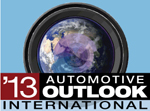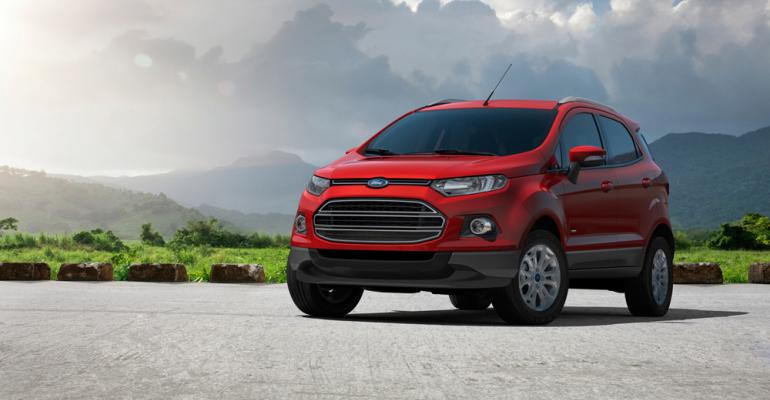South America’s auto industry continues to slug through a 1-year cooldown, with Brazil, its largest and most important market, using government stimulus to spur second-half vehicle sales and keep the region’s auto makers bullish on its prospects.
Brazil’s discount on its industrial product tax (IPI) for new vehicles, which the government lowered in August and later extended through October, has driven second-half deliveries to record highs and stretched waiting lists as long as 90 days for popular cars from local heavyweights Fiat and General Motors. Both auto makers have hiked production to meet demand following the sluggish first six months.
“The government stimulus is helping to offset the impact of the crisis in the domestic market,” Grace Lieblein, president of GM do Brasil, tells WardsAuto.
 The nexus of the economic slowdown in Brazil, which at 3.63 million units in 2011 accounted for 69% of South America’s 5.37 million vehicle sales, lies in the sovereign-debt crisis gripping Europe.
The nexus of the economic slowdown in Brazil, which at 3.63 million units in 2011 accounted for 69% of South America’s 5.37 million vehicle sales, lies in the sovereign-debt crisis gripping Europe.
Europe’s problems make borrowing more costly in most world markets and especially in Brazil where, despite nearly an entire year’s worth of interest-rate cuts, consumers continue to pay more than 6% on their car loans.
The high interest rates are onerous particularly for Brazil’s middle class, whose phenomenal growth began near the end of the last decade has helped vault the country to the fourth-largest automotive market globally behind China, the U.S. and Japan.
Yet, credit-default rates are on the rise, a surprise given the typically scrupulous borrowing behavior of Brazil’s population, further keeping rates high.
Other factors contributing to the pause in vehicle sales include Brazil’s weak currency, the real, which makes manufacturing expensive, drives up car prices and limits the profitability of exports.
This is causing used cars, some of them dumped on the market by China, to become more attractive to buyers, with sales jumping 25% to 11.7 million units in 2011 from 9.2 million just four years earlier, global consulting firm Roland Berger says.
In addition, burdensome local-content rules enacted by the new Brazilian government to stave off competition with the local industry makes new cars more expensive due to the high tax auto makers must pay on imported parts. It also means vehicles are less profitable to export, negating a major reason OEMs like building in the country.
Higher vehicle prices stifle the opportunity for consumers to upgrade from low-cost compact cars, which historically have plied the country’s streets, to the midsize and luxury vehicles that are more profitable for auto makers.
The impact of the tax also limits the car companies’ ability of to launch all-new products, forcing them instead to update existing platforms.
Trade agreements between Latin American nations keep changing, too, jeopardizing auto makers’ confidence in future planning. There has been particular contention this year among Brazil, Argentina and Mexico.
Such an uncertain environment led to a 0.7% sales downturn in South America’s vehicle sales for the year’s first half to 2.53 million units, and a 1.1% drop to 1.73 million units in Brazil, WardsAuto data shows.
Most forecasts are calling for flat year-over-year growth in the region this year, although many have ratcheted up their predictions given the Brazilian government’s extension of the IPI tax relief leading to a 28.4% sales spike in August before suffering a 7.9% decline in September. With the IPI extension, analysts expect a robust October.
 WardsAuto is forecasting Brazil 2012 vehicle sales to top out at 3.86 million units, up 6.3% from prior-year’s 3.63 million.
WardsAuto is forecasting Brazil 2012 vehicle sales to top out at 3.86 million units, up 6.3% from prior-year’s 3.63 million.
However, forecasting firm AutomotiveCompass is calling for South American light-vehicle production to fall 4.5% to 4.1 million units in 2012 from year-ago’s 4.3 million. Brazil’s output is predicted to drop 3.3% to 3.05 million units from 3.15 million in 2011.
Predictions of a backward slide are bringing increased fears of sudden overcapacity in Brazil, known for its seesaw economy. Mazda and Jaguar Land Rover, for example, changed course earlier this year, with the Japanese auto maker deciding against exporting to the market from its Mexico operations and the Indian-owned British marque killing plans for a local assembly plant.
Nevertheless, the general outlook for Brazil remains optimistic, based on continued economic development, including major infrastructure improvements, expansion of the important car-buying middle class, and major world events such as the 2014 World Cup in 12 different Brazilian states and the 2016 Summer Olympics in Rio de Janeiro.
AutomotiveCompass sees South American production rising 8.1% in 2013 to 4.43 million units, and output in Brazil growing 7.6% to 3.28 million. Roland Berger’s most optimistic scenario calls for car sales in Brazil to climb 8.8% to 3.7 million next year and 4.3 million in 2014.
“I am confident that the market will continue to grow in 2013,” Lieblein says, predicting a more conservative sales uptick of between 2% and 3% for Brazil next year.
Looking farther down the road, Anfavea, Brazil’s national association of auto makers, predicts vehicle sales will jump nearly 70% to 5.7 million units by 2016.
New federal tax breaks announced in early October for auto makers investing in science, technology and fuel efficiency makes Brazil additionally attractive.
While designed to increase production in the country, where output badly trails sales, consumers also stand to benefit because vehicles should be less expensive to buy. Importers would see a gain as well because they now are eligible for the same tax break if they make similar investments.
Government officials expect the tax breaks to increase local investment by auto makers, currently forecast at more than BR447 billion ($22 billion) by 2015.
Major player Fiat, for example, plans to spend BR6.1 ($3 billion) on a second assembly plant, using tax incentives and public financing to offset its costs, putting the Italian auto maker on a better footing to vie for the annual sales leadership with Volkswagen and GM. Fiat considers Brazil its largest global market.
GM, operating for nearly 90 years in Brazil, has invested BR5 billion ($2.5 billion) since 2008. The outlay is being used to modernize and expand its manufacturing facilities and locally develop technologies and vehicles to make its Chevrolet brand more attractive.
“To ensure that GM do Brasil remains a competitive manufacturing source is one of our top priorities,” Lieblein says.
Most other global players are equally bullish on Brazil. Korean auto maker Hyundai has invested BR1.2 billion ($600 million) in its new Piracicaba facility, which started production of the HB20 compact hatchback in September, a vehicle designed exclusively for the market.
French auto maker PSA Peugeot Citroen just launched a restyled C3 in Brazil’s hyper-competitive compact-car segment, part of a 5-year, BR3.7 billion ($1.8 billion) investment to double its manufacturing capacity in Porto Real.
Volkswagen, in Brazil for more than 50 years, intends to spend BR6.9 billion ($3.4 billion) by 2016. “We are stepping up our commitment to Brazil,” Michael Macht, management board member responsible for group production, says during a visit to the auto maker’s Anchieta assembly plant.
“We are making significant investments in the development of new products and the expansion of production capacities. Our target is to sell a million vehicles per year in Brazil by 2014.”
Ford, now in its 93rd year in South America, is in the midst of a $3 billion investment in the region. That includes BR4.9 billion ($2.4 billion) earmarked for Brazil, primarily focusing on the development in Camacari of the soon-to-launch Ford EcoSport small cross/utility vehicle for the domestic and export markets.
“The cadence of investment is maintained and (there is) no vision of changing that,” Rogelio Goldfarb, vice president-global affairs at Ford Brazil, tells WardsAuto. “We have been profitable for 34 quarters, and I think the challenge in South America is the increasing competition. To keep the pace with competition that’s coming, we need very competitive products.”
Nissan, BMW, Kia and China’s JAC, Geely and Chery, as well as India’s Tata and Mahindra, all have investment plans for the region. “Given the growth potential of Brazil, everyone wants in on this market,” Lieblein says.
“We see announcements regularly of new auto companies coming to Brazil to either import or build new plants here,” she adds, noting GM has launched seven new products for the market in the last 12 months and will add two more vehicles in the coming weeks to keep up with competitive pressure.
Roland Berger forecasts Brazil’s auto makers will add 2.5 million units of light-vehicle capacity by 2015 and another 220,000 units of commercial output.
Suppliers also stand to win in Brazil, the consultancy says, especially with the high domestic-content rules. Imported cars can get around the tax if 65% of their parts are sourced locally.
But parts makers could see pricing pressures soon, as Brazil’s auto makers try to offset rising labor costs and historically low levels of productivity and automation affecting the industry.





